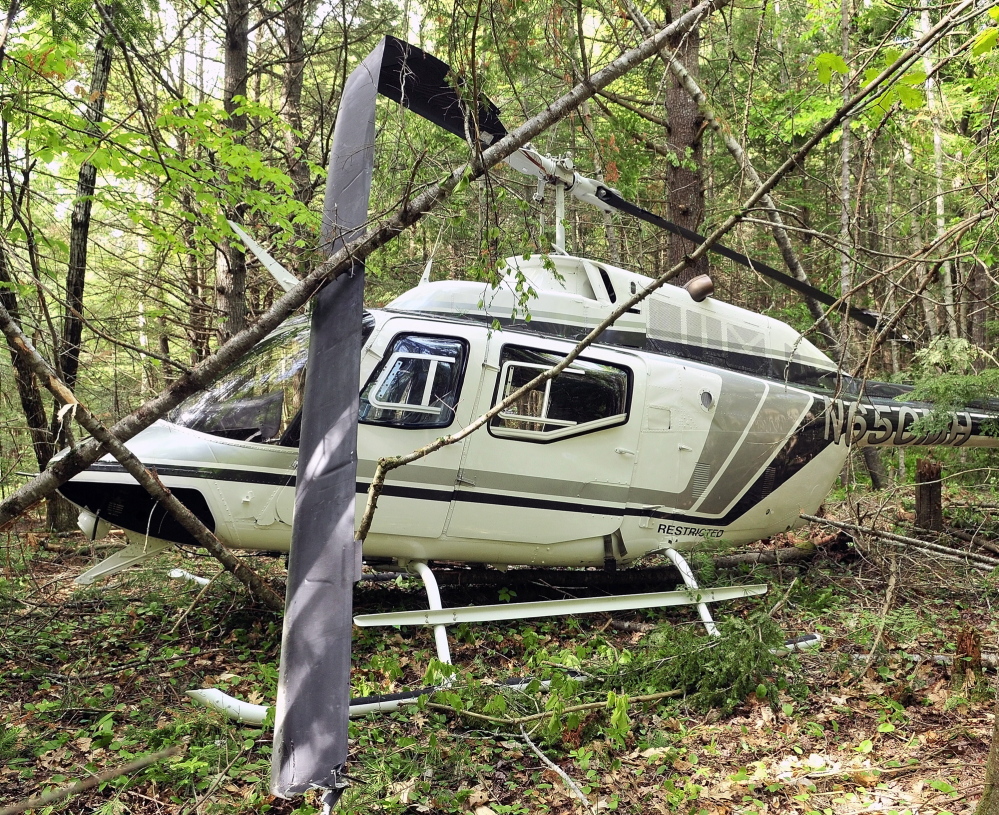National investigators have determined a helicopter that crashed in Whitefield last year was brought down by a combination of fuel loss and pilot error.
The report, which the National Transportation Safety Board released Wednesday, says the pilot, Michael J. Conley, failed to respond appropriately to a signal warning him of a lack of fuel. As a result, Conley was forced to crash land in the trees off East River Road near Clary Lake and Route 126.
Conley, who was flying for Whitefield-based Maine Helicopters, suffered a minor head injury. There was no one else on board.
“The published emergency procedure for this scenario was to land as soon as possible,” the report says. “Instead, the pilot continued flight as the master caution warning light illuminated three more times over the next 15 minutes.”
Investigators also determined that Conley, who was 50 at the time of the May 30, 2014, crash, failed to properly set the signals on the instrument panel.
“Examination of the master caution light and associated caution panel segment lights revealed that the segment lights were positioned in the ‘dim’ setting, which would have made it difficult or impossible to read in daylight conditions,” investigators wrote.
Conley’s decision to keep flying ultimately caused the aircraft to run out of usable fuel, investigators said. The NTSB determined the probable cause of the accident was a loss of power because of fuel starvation.
“Contributing to the accident was the pilot’s failure to land as soon as possible when the master caution warning light first illuminated as prescribed and his failure to ensure the proper setting of the caution panel segment lights before the flight,” investigators wrote.
The crash, which was reported around 2 p.m., left the helicopter, once used by the U.S. Army, badly damaged. Investigators have spent the past year trying to determine what caused the crash. Their final findings were made public this week.
Greg Farris, the Gardiner attorney who owns Maine Helicopters, said the report contained “zero surprises.”
“They confirmed what we sort of knew within 24 hours,” he said. “We really work hard on safety and we’ve got an unbelievable record. The one thing I can’t control is someone making a silly mistake.”
Farris said Conley, who lives in New Hampshire, hasn’t worked for the company since “shortly after the crash.”
There was no contact information available for Conley.
Conley told investigators that he left the Hancock County-Bar Harbor Airport in Trenton with 225 pounds of fuel, which would last for more than hour.
The 45-minute flight to Maine Helicopters was uneventful for the first 20 minutes when the master caution illuminated.
Conley said there was no discernible corresponding panel segment caution light. Conley said the gauge indicated he still had more than 100 pounds of fuel. The master caution flickered again five minutes later. The fuel gauge still indicated the helicopter had more than 100 pounds of fuel.
“Five minutes after that, the master caution warning light flickered a third time at a fuel reading of 100-125 pounds of fuel,” investigators wrote. “Thirty seconds later, at 50-100 pounds, the engine stopped producing power.”
Investigators determined the helicopter still had about 10 gallons, or 65 pounds, at the time of the crash, but only about 1.3 gallons of that was usable. Farris said there was not enough fuel to keep the engine going in the attitude, or position in respect to the horizon, that Conley was flying. Farris said Conley should have added fuel in Trenton.
Conley had logged more than 1,500 hours as the pilot in command, including more than 900 in a helicopter of the same make and model as the crash helicopter. It is unclear if he is still licensed to fly.
Staff Writer Michael Shepherd contributed to this report.
Craig Crosby — 621-5642
Twitter: @CraigCrosby4
Send questions/comments to the editors.



Success. Please wait for the page to reload. If the page does not reload within 5 seconds, please refresh the page.
Enter your email and password to access comments.
Hi, to comment on stories you must . This profile is in addition to your subscription and website login.
Already have a commenting profile? .
Invalid username/password.
Please check your email to confirm and complete your registration.
Only subscribers are eligible to post comments. Please subscribe or login first for digital access. Here’s why.
Use the form below to reset your password. When you've submitted your account email, we will send an email with a reset code.